2006 CHEVROLET CORVETTE mirror
[x] Cancel search: mirrorPage 256 of 426

Of course, traction is reduced when water, snow, ice,
gravel, or other material is on the road. For safety, you
will want to slow down and adjust your driving to
these conditions. It is important to slow down on slippery
surfaces because stopping distance will be longer and
vehicle control more limited.
While driving on a surface with reduced traction, try
your best to avoid sudden steering, acceleration, or
braking, including reducing vehicle speed by shifting to
a lower gear. Any sudden changes could cause the tires
to slide. You may not realize the surface is slippery until
your vehicle is skidding. Learn to recognize warning
clues — such as enough water, ice, or packed snow on
the road to make a mirrored surface — and slow down
when you have any doubt.
Remember: Any Anti-Lock Brake System (ABS) helps
avoid only the braking skid.
Racing or Other Competitive Driving
See your warranty book before using your vehicle for
racing or other competitive driving.
Notice:If you use your vehicle for racing or other
competitive driving, the engine may use more oil than
it would with normal use. Low oil levels can damage
the engine. For information on how to add oil, see
Engine Oil on page 5-16.Z06 Only: Be sure to check the oil level often during
racing or other competitive driving and keep the
level at or near the upper mark that shows the
proper operating range on the engine oil dipstick.
Except Z06: Be sure to check the oil level often
during racing or other competitive driving and keep
the level at or near 1 quart (1 L) above the upper
mark that shows the proper operating range on the
engine oil dipstick. After the competitive driving,
remove excess oil so that the level on the dipstick is
not above the upper mark that shows the proper
operating range.
Vehicles with the Z51 performance package have
greaseable outer ends on both of the rear toe-links.
Under normal use, lubrication should be performed as
described in the maintenance schedule. SeeScheduled
Maintenance on page 6-4andRecommended Fluids
and Lubricants on page 6-12. If you use the vehicle for
racing, lubrication should be performed at the end of
each racing day. See your dealer for lubrication
and make sure any needed repairs are made at once.
Proper procedures for performing these services can be
found in the service manual. SeeService Publications
Ordering Information on page 7-14.
4-18
Page 257 of 426
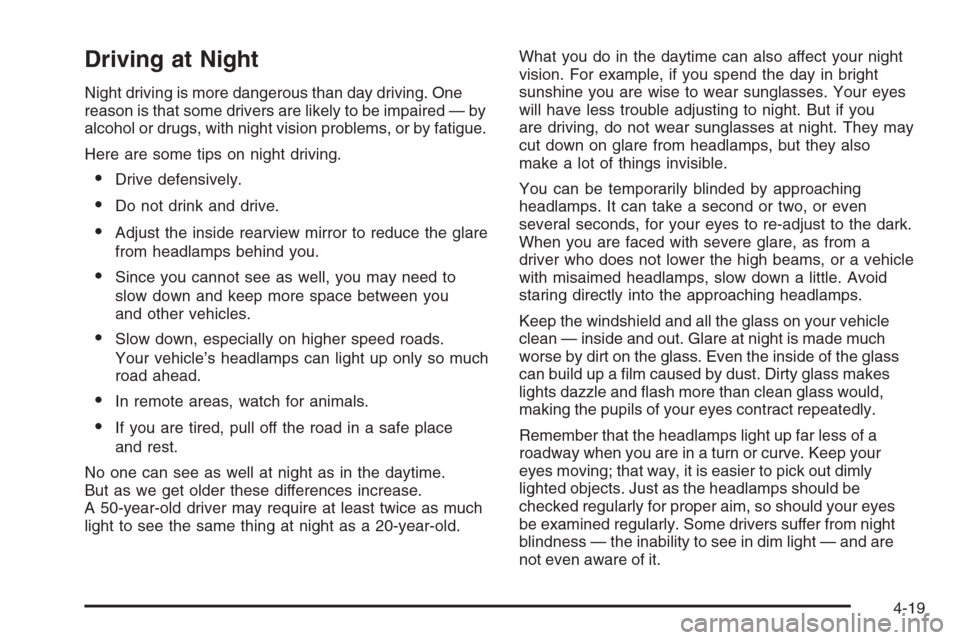
Driving at Night
Night driving is more dangerous than day driving. One
reason is that some drivers are likely to be impaired — by
alcohol or drugs, with night vision problems, or by fatigue.
Here are some tips on night driving.
Drive defensively.
Do not drink and drive.
Adjust the inside rearview mirror to reduce the glare
from headlamps behind you.
Since you cannot see as well, you may need to
slow down and keep more space between you
and other vehicles.
Slow down, especially on higher speed roads.
Your vehicle’s headlamps can light up only so much
road ahead.
In remote areas, watch for animals.
If you are tired, pull off the road in a safe place
and rest.
No one can see as well at night as in the daytime.
But as we get older these differences increase.
A 50-year-old driver may require at least twice as much
light to see the same thing at night as a 20-year-old.What you do in the daytime can also affect your night
vision. For example, if you spend the day in bright
sunshine you are wise to wear sunglasses. Your eyes
will have less trouble adjusting to night. But if you
are driving, do not wear sunglasses at night. They may
cut down on glare from headlamps, but they also
make a lot of things invisible.
You can be temporarily blinded by approaching
headlamps. It can take a second or two, or even
several seconds, for your eyes to re-adjust to the dark.
When you are faced with severe glare, as from a
driver who does not lower the high beams, or a vehicle
with misaimed headlamps, slow down a little. Avoid
staring directly into the approaching headlamps.
Keep the windshield and all the glass on your vehicle
clean — inside and out. Glare at night is made much
worse by dirt on the glass. Even the inside of the glass
can build up a �lm caused by dust. Dirty glass makes
lights dazzle and �ash more than clean glass would,
making the pupils of your eyes contract repeatedly.
Remember that the headlamps light up far less of a
roadway when you are in a turn or curve. Keep your
eyes moving; that way, it is easier to pick out dimly
lighted objects. Just as the headlamps should be
checked regularly for proper aim, so should your eyes
be examined regularly. Some drivers suffer from night
blindness — the inability to see in dim light — and are
not even aware of it.
4-19
Page 261 of 426
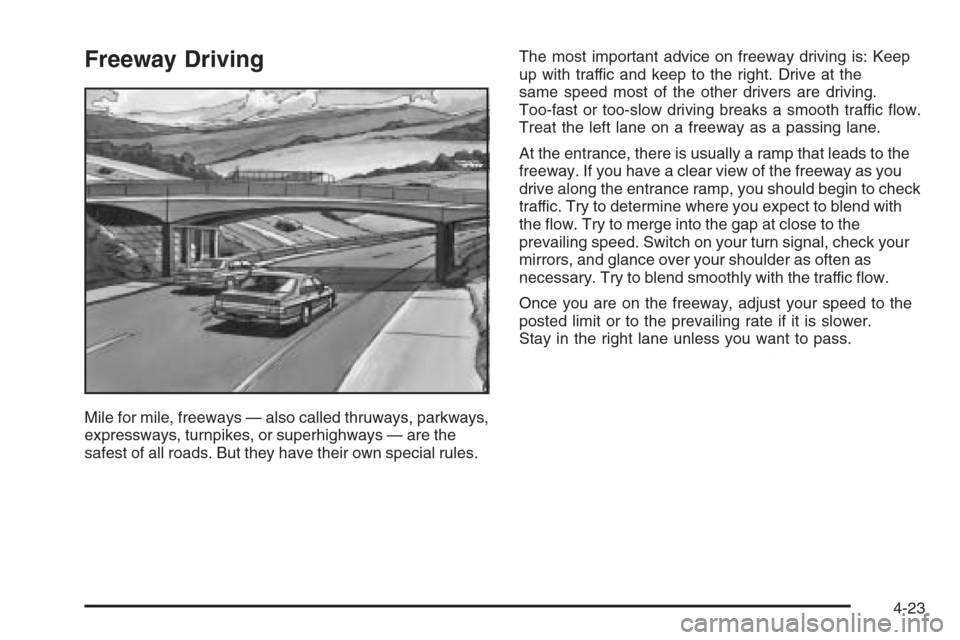
Freeway Driving
Mile for mile, freeways — also called thruways, parkways,
expressways, turnpikes, or superhighways — are the
safest of all roads. But they have their own special rules.The most important advice on freeway driving is: Keep
up with traffic and keep to the right. Drive at the
same speed most of the other drivers are driving.
Too-fast or too-slow driving breaks a smooth traffic �ow.
Treat the left lane on a freeway as a passing lane.
At the entrance, there is usually a ramp that leads to the
freeway. If you have a clear view of the freeway as you
drive along the entrance ramp, you should begin to check
traffic. Try to determine where you expect to blend with
the �ow. Try to merge into the gap at close to the
prevailing speed. Switch on your turn signal, check your
mirrors, and glance over your shoulder as often as
necessary. Try to blend smoothly with the traffic �ow.
Once you are on the freeway, adjust your speed to the
posted limit or to the prevailing rate if it is slower.
Stay in the right lane unless you want to pass.
4-23
Page 262 of 426
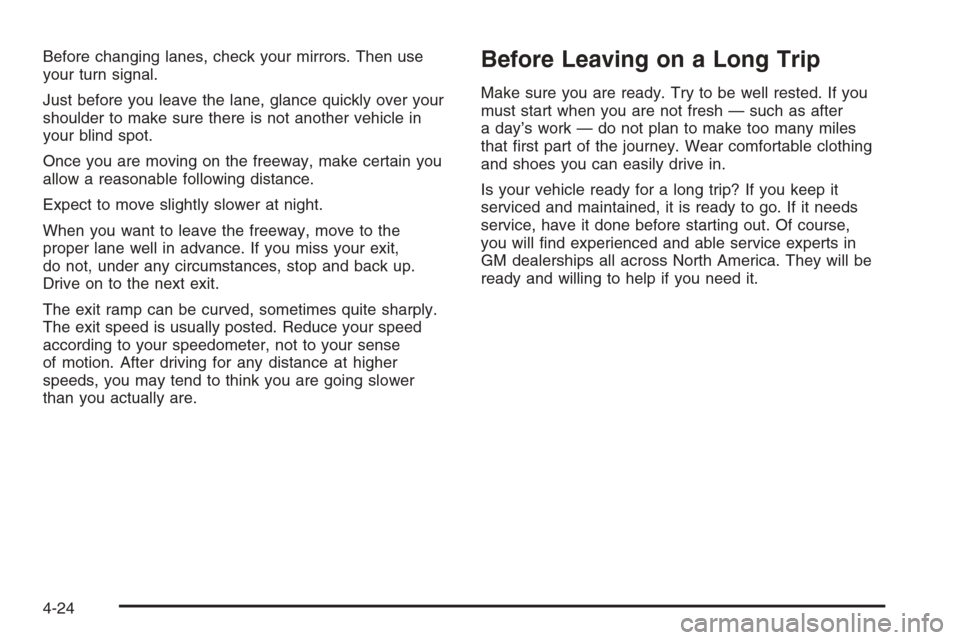
Before changing lanes, check your mirrors. Then use
your turn signal.
Just before you leave the lane, glance quickly over your
shoulder to make sure there is not another vehicle in
your blind spot.
Once you are moving on the freeway, make certain you
allow a reasonable following distance.
Expect to move slightly slower at night.
When you want to leave the freeway, move to the
proper lane well in advance. If you miss your exit,
do not, under any circumstances, stop and back up.
Drive on to the next exit.
The exit ramp can be curved, sometimes quite sharply.
The exit speed is usually posted. Reduce your speed
according to your speedometer, not to your sense
of motion. After driving for any distance at higher
speeds, you may tend to think you are going slower
than you actually are.Before Leaving on a Long Trip
Make sure you are ready. Try to be well rested. If you
must start when you are not fresh — such as after
a day’s work — do not plan to make too many miles
that �rst part of the journey. Wear comfortable clothing
and shoes you can easily drive in.
Is your vehicle ready for a long trip? If you keep it
serviced and maintained, it is ready to go. If it needs
service, have it done before starting out. Of course,
you will �nd experienced and able service experts in
GM dealerships all across North America. They will be
ready and willing to help if you need it.
4-24
Page 263 of 426
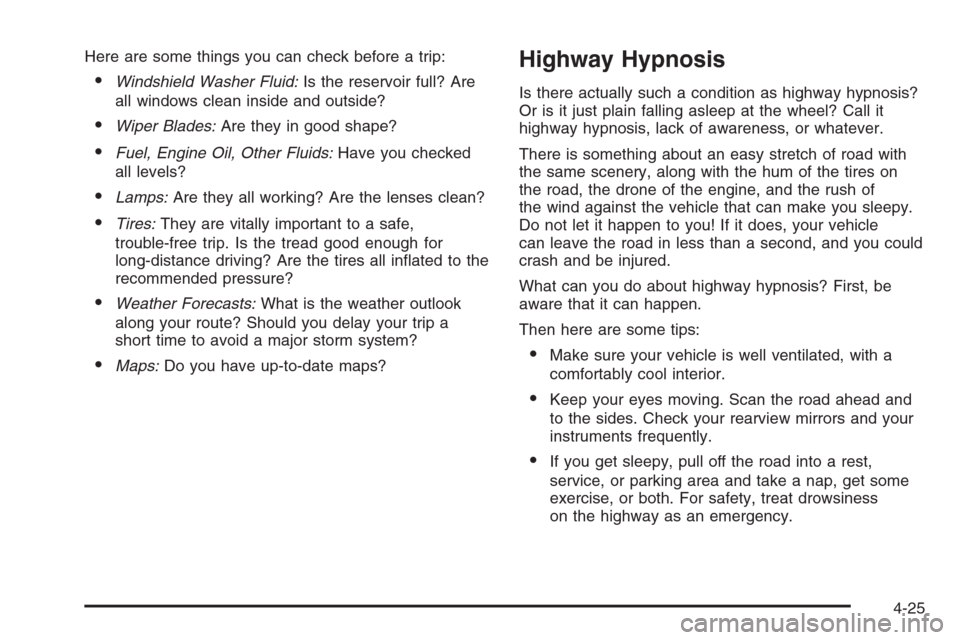
Here are some things you can check before a trip:
Windshield Washer Fluid:Is the reservoir full? Are
all windows clean inside and outside?
Wiper Blades:Are they in good shape?
Fuel, Engine Oil, Other Fluids:Have you checked
all levels?
Lamps:Are they all working? Are the lenses clean?
Tires:They are vitally important to a safe,
trouble-free trip. Is the tread good enough for
long-distance driving? Are the tires all in�ated to the
recommended pressure?
Weather Forecasts:What is the weather outlook
along your route? Should you delay your trip a
short time to avoid a major storm system?
Maps:Do you have up-to-date maps?
Highway Hypnosis
Is there actually such a condition as highway hypnosis?
Or is it just plain falling asleep at the wheel? Call it
highway hypnosis, lack of awareness, or whatever.
There is something about an easy stretch of road with
the same scenery, along with the hum of the tires on
the road, the drone of the engine, and the rush of
the wind against the vehicle that can make you sleepy.
Do not let it happen to you! If it does, your vehicle
can leave the road in less than a second, and you could
crash and be injured.
What can you do about highway hypnosis? First, be
aware that it can happen.
Then here are some tips:
Make sure your vehicle is well ventilated, with a
comfortably cool interior.
Keep your eyes moving. Scan the road ahead and
to the sides. Check your rearview mirrors and your
instruments frequently.
If you get sleepy, pull off the road into a rest,
service, or parking area and take a nap, get some
exercise, or both. For safety, treat drowsiness
on the highway as an emergency.
4-25
Page 372 of 426

Fuses Usage
ISRVM/ HVACElectric Inside Rearview Mirror,
Heating Ventilation, Air Conditioning
CRUISE SW Cruise Control Switch
TONNEAU
RELSETonneau Release
RUN CRNK Run/Crank Relay
HTD SEAT/
WPR RELAYSHeated Seat, Wiper Relays
ECM Engine Control Module
SDM/PSIR SW
AIRBAGSensing and Diagnostic Module,
Automatic Occupant Sensing Module
CLSTR/HUD Cluster, Heads-Up Display
HVAC/
PWR SNDHeating, Ventilation/Air Conditioning,
Power Sounder
SPARESpare (Coupe, Convertible); Exhaust
Module (Z06)Fuses Usage
DR LCK Door Locks
CTSY/LAMP Courtesy Lamp
BLANK Not Used
Fuses Usage
TONNEAU
RELSETonneau Release
TRUNK RELSE Trunk Release
REAR/FOG Rear Fog Lamps
FUEL DR
RELSEFuel Door Release
BLANK Not Used
BLANK Not Used
5-96
Page 421 of 426

Mirrors
Automatic Dimming Rearview with Compass....2-41
Automatic Dimming Rearview with
OnStar
®and Compass..............................2-38
Manual Rearview Mirror................................2-38
Outside Automatic Dimming Mirror.................2-44
Outside Convex Mirror.................................2-44
Outside Power Heated Mirrors.......................2-43
MyGMLink.com................................................ 7-3
N
Navigation/Radio System, see
Navigation Manual.......................................3-99
New Vehicle Break-In......................................2-21
Normal Maintenance Replacement Parts............6-14
O
Odometer......................................................3-34
Off-Road Recovery..........................................4-15
Oil
Engine.......................................................5-16
Engine Oil Pressure Gage............................3-45
Oil, Engine Oil Life System..............................5-23Older Children, Restraints................................1-22
One-to-Four Shift Light....................................3-38
Online Owner Center........................................ 7-3
OnStar
®System, see OnStar®Manual...............2-45
Other Warning Devices...................................... 3-6
Outlet Adjustment............................................3-30
Outlet(s), Accessory Power...............................3-24
Outside
Automatic Dimming Mirror.............................2-44
Convex Mirror.............................................2-44
Power Heated Mirrors..................................2-43
Overheated Engine Protection Operating Mode.....5-34
Owner Checks and Services.............................. 6-8
Owners, Canadian............................................... ii
P
Paint, Damage...............................................5-90
Park (P)
Shifting Into................................................2-33
Shifting Out of............................................2-35
Parking
Brake........................................................2-33
Over Things That Burn.................................2-36
Parking Your Vehicle.......................................2-35
9
Page 422 of 426
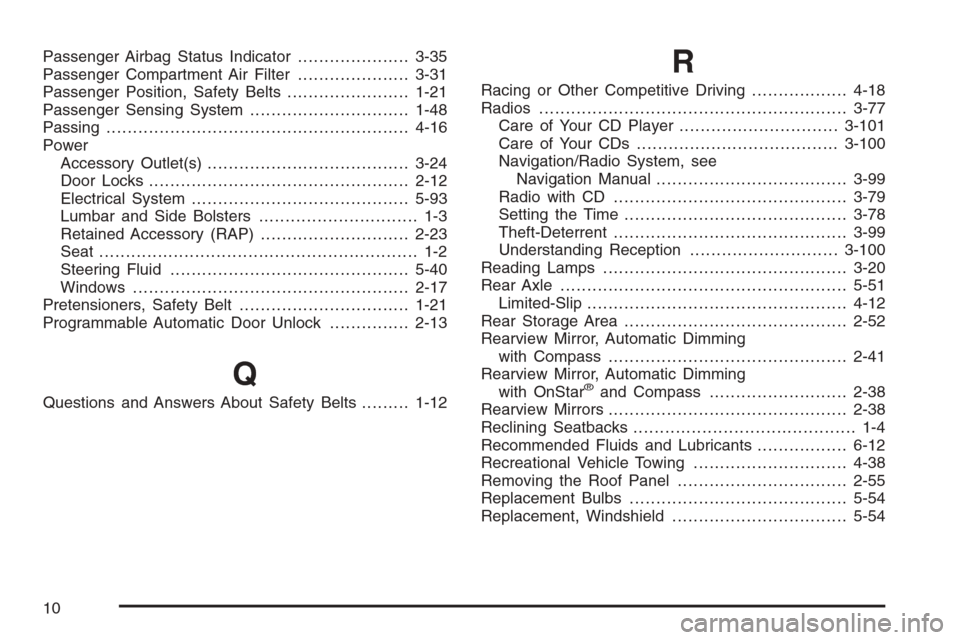
Passenger Airbag Status Indicator.....................3-35
Passenger Compartment Air Filter.....................3-31
Passenger Position, Safety Belts.......................1-21
Passenger Sensing System..............................1-48
Passing.........................................................4-16
Power
Accessory Outlet(s)......................................3-24
Door Locks.................................................2-12
Electrical System.........................................5-93
Lumbar and Side Bolsters.............................. 1-3
Retained Accessory (RAP)............................2-23
Seat ............................................................ 1-2
Steering Fluid.............................................5-40
Windows....................................................2-17
Pretensioners, Safety Belt................................1-21
Programmable Automatic Door Unlock...............2-13
Q
Questions and Answers About Safety Belts.........1-12
R
Racing or Other Competitive Driving..................4-18
Radios..........................................................3-77
Care of Your CD Player..............................3-101
Care of Your CDs ......................................3-100
Navigation/Radio System, see
Navigation Manual....................................3-99
Radio with CD............................................3-79
Setting the Time..........................................3-78
Theft-Deterrent............................................3-99
Understanding Reception............................3-100
Reading Lamps..............................................3-20
Rear Axle......................................................5-51
Limited-Slip.................................................4-12
Rear Storage Area..........................................2-52
Rearview Mirror, Automatic Dimming
with Compass.............................................2-41
Rearview Mirror, Automatic Dimming
with OnStar
®and Compass..........................2-38
Rearview Mirrors.............................................2-38
Reclining Seatbacks.......................................... 1-4
Recommended Fluids and Lubricants.................6-12
Recreational Vehicle Towing.............................4-38
Removing the Roof Panel................................2-55
Replacement Bulbs.........................................5-54
Replacement, Windshield.................................5-54
10